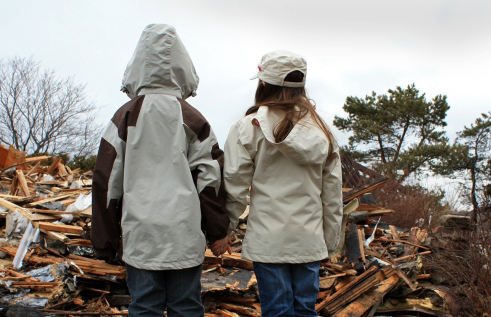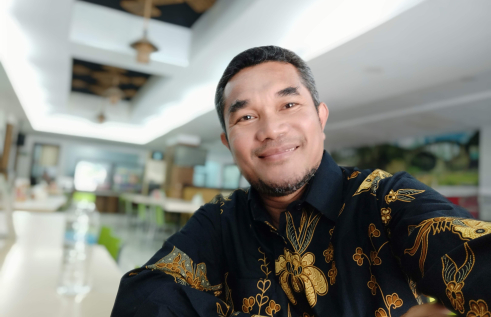Research impact
Is there such a thing as 'natural' disasters?

Is being vulnerable to the forces of nature entirely due to our social, economic and political decisions? This is a question Dr Jonatan Lassa, a senior lecturer in Humanitarian, Emergency and Disaster Management at CDU, explores in his research and teaching. Read on to see what he's discovered about saving lives, having examined 40 years of critical disasters.
Amidst global calamities, it's time to ask the fundamental question: Is there anything natural about natural disasters?
Vulnerable housing and buildings that collapsed in the 2016 earthquake in Italy, Haiti's Hurricane Matthew and Nepal's 2015 earthquake are all examples of how public policy failed to ensure the resilience of new and old buildings to earthquakes.
Critical disaster studies have long argued that natural disasters do not exist. The overemphasis on the naturalness of the natural events, such as earthquakes and storms, as the root cause of disasters has been contested for at least the last 260 years.
Let's be critical: Most planets experience quakes. On Earth, these are called earthquakes. On Mars, they're called marsquakes. On the Moon, they're moonquakes. Here on Earth, we experience at least 1.44 million earthquakes a year*. And remember that the Earth is like a moving spaceship. It moves like a giant airplane orbiting the sun and during that process, its stresses and strains are released to the surface.
How do social-economic factors change the impact of earthquakes?
In 2016, it was the 40th anniversary of an article published in Nature entitled “Taking the naturalness out of natural disasters”. Using empirical global economic loss data, Phil O'Keefe and his colleagues at Bradford University in the UK, showed that social-economic factors are responsible for the loss of lives and the loss of or damage to the assets following natural disasters in the developing world - not natural factors.
They are not the only group that makes this assertion. Research communities in the field of critical disasters have spent years producing consistent findings and lobbying policy makers on the global stage. The United Nations, namely the United Nations International Strategy for Disaster Reduction (UNISDR), has finally adopted the critical approach to disasters, suggesting that there is no such thing as a ‘natural’ disaster, only natural hazards.
UNISDR now maintains that natural hazards are natural processes and/or events that may cause the loss of life, assets, livelihoods and services and so on, depending on the degree of vulnerability and exposure. UNISDR explains that a disaster's degree of severity depends on our “choices (and) relate to how we grow our food, where and how we build our homes, what kind of government we have, how our financial system works and even what we teach in schools. Each decision and action makes us more vulnerable to disasters — or more resilient to them”.
Changing paradigms: Lessons learnt in Lisbon
The Lisbon Earthquakes on 1 November, 1755 marked a revolutionary shift in the way social science scholars thought about disasters – at least in the context of continental Europe in the late 18th century.
It was not an ordinary Saturday morning. At about 9.30am, earthquakes estimating a magnitude of 8.5-9.0 hit the city and triggered large-scale tsunamis. According to some estimates, about 17,000 out of 20,000 buildings collapsed and caused about 70,000 deaths. Half of those may have been because of collapsing buildings; while the others were due to post-earthquake fire and lack of post-disaster response, as the wounded outnumbered the number of first responders and rescuers.
Back then, Portugal was one of the world's great nations and Lisbon was a symbol of progression for human civilisation. The great French philosopher, Voltaire, saw the earthquake as a sign of God showing His power, glory and might. Voltaire wrote deep emotional poems after the earthquake to encouraging suffering Christians to be repentant and resilient in their faith in God. But Jean-Jacques Rousseau, a younger French philosopher, challenged Voltaire.
In a letter, he stated the obvious: nature did not construct the thousands of houses and multi-storey that collapsed.
In Western philosophical thinking, we accept the claim from some that Rousseau’s letter to Voltaire symbolised the beginning of a change in thinking that led to new ways of interpreting disasters.
The debate is moving in the right direction
Some primitive responses to misfortunes and calamities from natural events automatically activate certain interpretations that reinforce norms, values and beliefs. The religious may seek well-suited theological interpretations to justify natural events as divine interventions to correct the behaviour of the sinners. In Southeast Asia, I have seen these narratives repeated in Aceh after the Indian Ocean Tsunami 2004 and Padang earthquakes in 2009.
Today, while scholars of different disciplines agree on the need to adopt formalised terms and definitions, the debate on the words and terms we use continues. The debate is moving in the right direction: we understand the reality and must continue to work on translating our insights and research findings into policy making and industry practices.
Authored by Dr Jonatan Lassa, a senior lecturer in Humanitarian, Emergency and Disaster Management at CDU
Want to be part of an industry that's helping to respond to disasters? Study your way to success with a course in Humanitarian, Emergency and Disaster Management from CDU. You'll learn from industry experts, examine real-life case studies, and benefit from close connections with government, NGOs and leading aid agencies. Explore our courses.
* United States Geological Survey, www.usgs.gov
Related Articles

Mohammad dreams of building disaster-resilient communities
Mohammad dreams of developing disaster-resilient communities in Indonesia, so he began his search for a Higher Degree by Research and was granted an Australia Awards Scholarship. His research could make a big impact on small islands threatened by a host of natural disasters.
Read more about Mohammad dreams of building disaster-resilient communities
Age is no barrier to making an impact in emergencies
Meet the emergency services veteran who, at 80, went to university to consolidate a lifetime of on-the-job learning and help shape the future direction of emergency management.
Read more about Age is no barrier to making an impact in emergencies
Theory in action: Stephanie's overseas placement
In her final year of a Bachelor of Humanitarian and Community Studies, Stephanie completed a student placement with the Red Cross in Timor-Leste. She reflects on the placement – and dissects why it was such a formative personal, professional, and academic experience.
Read more about Theory in action: Stephanie's overseas placement
